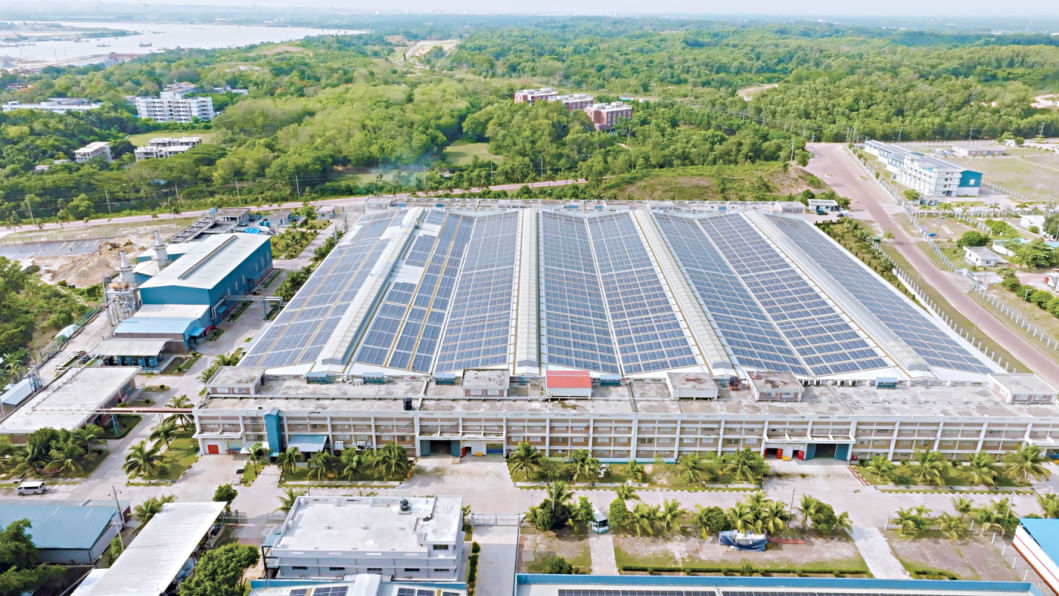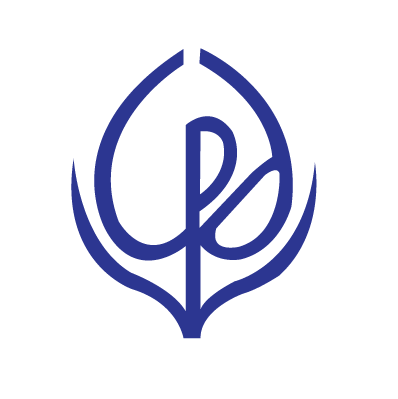Originally posted in The Daily Star on 21 September 2025
Factories slash carbon in rooftop solar push
Industries embrace rooftop solar as Bangladesh balances climate risks, export competitiveness

The world’s energy landscape is at a tipping point. Environmental necessities, economic opportunities, and geopolitics are forcing a shift towards renewables. For a growing export-dependent and climate-vulnerable economy like Bangladesh, the stakes are high.
And industries are moving. They are gradually turning rooftops into miniature power plants. Those who were wary even two years ago are now installing vast solar panels on factory rooftops on their own.
The spread is now visible in export-processing zones, pharmaceutical complexes, and garment clusters. Youngone Corporation, a Korean conglomerate, was one of the earliest movers. In 2021, it built Bangladesh’s largest rooftop solar plant in the Korean Export Processing Zone in Chattogram.
The project began with 16 megawatt-peak (MWp) and has since grown to 37 MWp, producing 120 to 140 megawatt-hours daily. For context, one MWp of solar can typically meet the daytime electricity needs of around 300-400 households.
“Solar meets a large share of our energy demand. Our immediate focus is to expand capacity further, targeting 50 MWp,” said Md Shahjahan, managing director of the zone.
He estimates the project has already cut 95,760 tonnes of carbon dioxide emissions.
Renata PLC, one of the country’s leading pharmaceutical firms, has installed 5.6 MWp, reducing carbon emissions by 3.5 million kilogrammes annually and meeting 10 percent of its total power consumption.
“Our primary reason is to protect our environment by reducing carbon emissions,” said Razib Hasan, the company’s general manager of the Project Management Division.

“Besides, solar power makes us more energy independent and less vulnerable to load shedding, while proving economical over its twenty-year lifecycle,” he said.
According to Hasan, Renata plans to expand capacity to 6.6 MWp.
Ha-Meem Group, one of the largest diversified Bangladeshi conglomerates, has built 12.2 MWp across its factories, cutting emissions by about 6 percent.
“The company is committed to global sustainability forums and buyer compliance requirements,” said Tanul Chakraborty, who heads its energy department.
Ha-Meem has pledged to reach net zero by 2050, a goal that will require another 300 MWp. The group is planning a large-scale solar plant in Moulvibazar.
This year, it added a 4.4 MWp system at its Kaliganj industrial park in Gazipur and plans another 15 MWp by mid-2026. “If any factory has available rooftops, especially those with shed buildings, they should adopt solar without hesitation,” Chakraborty said.
“This has been very encouraging over the last two years,” said Alamgir Morshed, executive director and chief executive officer of the Infrastructure Development Company Limited (Idcol), the state-owned financier for renewables.
According to him, solar has emerged as a proven way to cut costs. Factories pay Tk 10-12 per kilowatt-hour (kWh) of grid electricity — the amount needed to run an air conditioner for 40 minutes. Rooftop solar delivers power at nearly half that rate. “The economic benefit of rooftop solar is now clear for industries.”
Technological concerns had also largely faded. “Solar is not complicated, and customers now trust it,” Morshed said.
Md Enamul Karim Pavel, Idcol’s head of renewable energy, reported that in the past eight months, more than 30 companies had expressed interest in rooftop installations. “So far, Idcol has financed 165 megawatt-peak across 52 factories.”
The state-owned financial institution estimates that Bangladesh has the potential to generate 4,000 MWp of electricity by installing rooftop solar panels on ready-made garment (RMG), textile, and other industrial buildings.
The use of green electricity to meet part of the energy requirement is also a good option for entrepreneurs, especially exporters.
GLOBAL BUYERS ENCOURAGE GREEN POWER
Today, global brands are binding their suppliers to climate commitments. Most top apparel companies have signed onto the UN’s Science Based Targets initiative, which requires measurable reductions in emissions.
American Eagle now demands that at least 10 percent of the electricity used by its tier-one and tier-two suppliers come from renewables. Levi Strauss & Co and GAP have pledged 42 percent emission cuts by 2030.
Meanwhile, leading Belgian apparel brand Stanley/Stella outlined its goal to cut Scope 3 carbon emissions, indirect greenhouse gas emissions that occur in a company’s value chain, by 30 percent by 2030.
At a meeting with the Bangladesh Garment Manufacturers and Exporters Association (BGMEA) on Thursday, it praised Bangladesh’s progress in expanding renewable energy and stressed closer cooperation with local suppliers to adopt greener technologies.
To this regard, Ha-Meem Group’s Chakraborty said compliance is no longer optional for factories in Bangladesh.
“Without evidence of renewable sourcing, contracts are at risk. We are now required to submit a plan to buyers outlining how we will reduce emissions year by year,” he said.
The risk of the end of subsidies on energy in the coming years is also driving decisions. Once subsidies on electricity are withdrawn, prices are likely to rise sharply.
“Without subsidies, industries could end up paying Tk 20 per kWh for grid electricity. That could trigger deindustrialisation overnight. Renewable energy is the only viable path for industrial competitiveness,” warned M Zakir Hossain Khan, chief executive officer of Change Initiative, a research think tank.
Khondaker Golam Moazzem, research director at the Centre for Policy Dialogue (CPD), said even without major policy support, businesses saw the economic benefits and moved ahead.
He added, “We have also seen new merchandise power purchase agreements, such as one signed between Pran-RFL Group and H&M.”
“This is encouraging, as it opens new opportunities for private-sector contracts. Those unable to set up plants themselves can still benefit through the grid using such agreements, creating fresh possibilities.”
Authorities do not have any separate data on rooftop solar installed by factories.
But the Sustainable and Renewable Energy Development Authority (Sreda), Bangladesh, estimates that 3,909 rooftop solar panel units are producing around 190 MWp of electricity under the net metering system, covering offices, factories, and households.
The amount is meagre given the renewable energy generation potential from rooftop solar and the government’s target.
The interim government has launched a National Rooftop Solar Programme, mandating installations on public buildings and targeting 3,000 megawatt-peak by December 2025.
In the longer term, it promises 30 percent renewable energy by 2040. To meet this plan, solar capacity would need to increase twelvefold in six months.
Experts say the goal is too ambitious. Past targets of generating five percent of total energy needs through renewables by 2015 and 10 percent by 2020 were missed.
Industry stakeholders said addressing the challenges to rooftop solar would help meet the target better.
CHALLENGES ARE MANY
Financing remains a central hurdle. Solar requires a high upfront investment, and loans from commercial banks are short-term and costly.
“Industries moving to rooftop or floating solar need subsidies and affordable financing,” Idcol’s Khan said. “Investors should be offered very low-interest loans, with the government covering the interest component.”
The net metering system, which allows factories to sell excess electricity back to the grid, often takes months of paperwork and multiple approvals. The system is yet to be implemented in export-processing zones (EPZs).
However, Bepza, the agency mandated to manage EPZs, said it is taking necessary steps to introduce net-metering in accordance with the government’s “Net Metering Guidelines – 2025” issued by SREDA.
“This will soon enable industries inside EPZs to integrate more effectively with the national renewable energy framework. BEPZA remains firmly committed to sustainable and green industrialisation in Bangladesh,” said ASM Anwar Parvez, executive director (Public Relations) at Bepza.
Furthermore, the organisation said it actively encourages industries to adopt renewable energy.
“At present, nearly 22 MW on-grid solar power is being generated inside the EPZs, against the total demand of about 220 MW. Both BEPZA and EPZ industries have installed solar panels on the rooftops of their buildings and factories, and this expansion is continuing.”
While technology has advanced, it is still not optimal. When the grid is unstable, factories cannot always feed surplus electricity back. Storage solutions, such as batteries, remain too costly.
Mostafa Al Mahmud, president of the Bangladesh Sustainable and Renewable Energy Association, said that while many industries have installed solar systems, without proper back-feed into the grid, a lot of electricity goes to waste whenever the national grid is down.
“Major global buyers’ push for cutting carbon emissions is driving adoption in the garment industry. But as a nation, our dependence on imported fuels and subsidies is putting enormous pressure on the economy. Renewables are the rational way forward.”
Gas reserves are dwindling fast. According to Petrobangla, recoverable reserves now stand at about 8.5 trillion cubic feet. At the current extraction rate, this reserve will last for about eleven more years, though experts say the realistic figure is closer to eight.
Duties on solar equipment remain high, and small-scale incentives are absent.
“Take the example of lithium iron phosphate batteries. The government reduced some duties on them, but not in a meaningful way. The main components of lithium-ion systems, lithium cells, pack materials, and battery management systems, have seen no duty reductions,” said Mahmud.
Although solar panels are supposed to enjoy lower duties, buyers still face 14 to 28 percent in advance income tax and other charges. “This is contradictory. The government provides large subsidies to the energy sector, but has not waived duties on renewable energy equipment.”
“No project succeeds without incentives. Installing a one-kilowatt solar system costs Tk 40,000 to Tk 50,000. But no such measure exists,” he added.
Ashraful Alam, a member of Sreda’s renewable wing, said the main reason is that rooftop solar on factories has been voluntary as of now.
“People were not forced to do it. They did it if they saw profit. Many installed it, many did not. A lot of it was off-grid, mainly solar home systems in villages. These do not go into the grid; they are purely off-grid.”



